Today’s Current Affairs: 30th March 2023 for UPSC IAS exams, State PSC exams, SSC CGL, State SSC, RRB, Railways, Banking Exam & IBPS, etc
Table of Contents
Cloned Cow-calf:
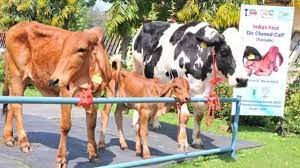
The National Dairy Research Institute (NDRI), Karnal has produced cloned female calves of the desi breed Gir.
- Cloned Cow-calf is India’s first cloned Gir female calf named Ganga.
- To clone the Gir, oocytes are isolated from live animals using ultrasound-guided needles, and then, matured for 24 hours under control conditions.
- The somatic cells of elite cows are used as donor genomes, which are fused with OPU-derived enucleated oocytes. Following chemical activation and in-vitro culture, the developed blastocysts are transferred into recipient mothers to deliver the Gir calf.
Cloning:
- The term cloning describes a number of different processes that can be used to produce genetically identical copies of a biological entity.
- Cloning can be natural or artificial.
- Clones can also be produced through artificial means. Biotechnological methods are employed to produce such clones.
- Molecular cloning, where copies of specific gene fragments are produced
- Cellular cloning, where single-celled organisms with the exact genetic content of the original cell are produced in cell cultures.
- Organism cloning, or reproductive cloning, where a multicellular clone is created generally through somatic cell nuclear transfer
TRAPPIST-1 b : New Observations

New observations from the James Webb Space Telescope reveal that TRAPPIST-1b is unlikely to have an atmosphere wrapped around its rocky body.
- TRAPPIST-1 b is a hot rocky exoplanet orbiting an ultracool red dwarf star TRAPPIST-1.
- It is the innermost of seven known planets in the TRAPPIST-1 system.
- It has 1.4 times the mass and 1.1 times the radius of Earth.
- It orbits its star at a distance of 0.011 astronomical unit (AU), completing one circuit in just 1.51 Earth days.
- It receives about four times the amount of energy that Earth gets from the Sun.
- TRAPPIST-1b is tidally locked, meaning that one side of the planet always faces the star, and one side looks away.
Z-Morh Tunnel:

Union Minister for Road Transport and Highways said that the crucial Z-Morh tunnel will be inaugurated soon.
- Z-Morh Tunnel is an under-construction 2-lane road tunnel between Gagangir and Sonamarg on the Srinagar-Leh Highway in Jammu and Kashmir.
- It is named for the Z-shaped stretch of road between Sonamarg and Gagangir that the tunnel will replace.
- Length: 6.5 km
- The tunnel is designed for the flow of 1,000 vehicles an hour at an approved maximum speed of 80 km per hour
- At 8,960 feet, tourist destination Sonmarg is covered in snow during the winter season, forcing locals to shift to Srinagar.
- Z-Morh tunnel will ensure that Sonmarg town in Jammu & Kashmir remains connected as well as supplies are maintained all year round.
- It will ensure all-weather connectivity between Srinagar in Jammu and Kashmir and Kargil in Ladakh.
- Along with the 14.15 km Zojila Tunnel to its east, it aims to enhance the Indian military’s capabilities in Kashmir and Ladakh along both the Line of Control (LOC) to the north and the Line of Actual Control (LAC) further east.
Challenger 2 Main Battle Tank:
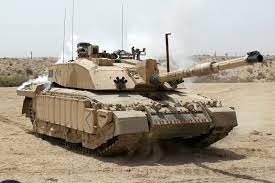
The first British Challenger 2 main battle tank recently arrived in Ukraine.
- Challenger 2 Main Battle Tank is the British Army’s main battle tank (MBT).
- It is a third-generation MBT, the same generation as the Russian T-80 and T-90 tanks.
- It is heavily armoured and highly mobile, designed for use in direct fire zones.
- Its primary role is to destroy or neutralise armour, Challenger 2 can operate across a spectrum of high-intensity conflict, counter-insurgency and peacekeeping roles.
- It is in service with the United Kingdom (386) and Oman (38).
- The armour of the Challenger-2 is called the Chobham armour or the Dorchester armour and is considered among the best in the world.
- The tank is 27 feet long and eight feet tall.
- It has a range of 547 kilometres with a maximum speed of 59 kilometres per hour.
- It is armed with a rifled Royal Ordnance L30 120-mm main gun, which can deliver main armament rounds up to a range of around four kilometres.
- The secondary armament consists of two 7.62 mm machine guns.
Biotransformation Technology : To Make Plastics Biodegradable

A UK-based startup has claimed to have developed a Biotransformation Technology that could alter the state of plastics and make them biodegradable.
- Biotransformation technology is a novel approach to ensure plastics that escape refuse streams are processed efficiently and broken down.
- Plastics made using this technology are given a pre-programmed time during which the manufactured material looks and feels like conventional plastics without compromising on quality.
- Once the product expires and is exposed to the external environment, it self-destructs, and bio transforms into bioavailable wax.
- This wax is then consumed by microorganisms, converting waste into water, CO2, and biomass.
- This biotransformation technology is the world’s first that ensures polyolefins fully biodegrade in an open environment causing no microplastics.
State Of India’s Environment Report 2023:
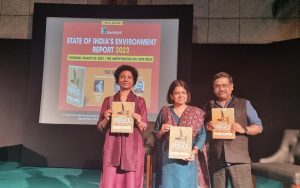
State of India’s Environment report 2023 was launched by Centre for Science and Environment (CSE) and DTE (Down to Earth)
Highlights of the Report:
- Over 30,000 water bodies have been encroached on in the country and India is generating 150,000 tonnes of Municipal Solid Waste (MSW) every day more than half of which is either dumped in landfills or remains unattended.
- Four years and 11 months is the average duration of life lost to air pollution in India.
- Rural India is losing more years due to air pollution-related health issues than the urban belt.
- Rural India needs 35 % more community health centers.
- Environmental crimes continue unabated ,courts need to decide on 245 cases every day to clear the backlog.
- Between January and October 2022, India witnessed extreme weather events on 271 days.
- These extreme weather events claimed over 2,900 lives.
- Over the past five years, India’s overall global rank in meeting the United Nations-mandated Sustainable Development Goals (SDGs) has slipped by nine places — ranking 121 in 2022. India ranks below four south Asian countries — Bangladesh, Bhutan, Sri Lanka and Nepal
- In agriculture, strong evidence is emerging of the efficacy of traditional and regenerative farming methods.
PMFME Scheme:

The Ministry of Food Processing Industries (MoFPI) is implementing a centrally sponsored PM Formalisation of Micro Food Processing Enterprises Scheme (PMFME) Scheme for providing financial, technical, and business support to micro food processing enterprises in India.
- This scheme is a part of the Atmanirbhar Bharat Abhiyan – Vocal for Local Initiative in the food processing sector.
- The PMFME scheme aims to enhance the competitiveness of new and existing individual micro-enterprises in the unorganized segment of the food processing industry and promote formalization of the sector.
- The PMFME scheme is operational for a period of five years from 2020-21 to 2024-25 with an outlay of Rs. 10,000 Crore.
- The scheme adopts the One District One Product (ODOP) approach to reap the benefit of scale in terms of procurement of inputs, availing common services and marketing of products.
- Other Focus areas include Waste to wealth products, minor forest products and Aspirational Districts.
Daylight Saving Time (DST):

Lebanon saw mass confusion after its government at the last minute delayed the start of daylight saving time by a month.
- Lebanon usually sets its clocks forward an hour on the last Sunday in March.
- Prime Minister said this year, the clocks would be reset on 21 April, without citing any reason.
- It is the practice of turning the clock ahead as warmer weather approaches and back as it becomes colder again.
- The practice was first suggested by Benjamin Franklin in 1784.
- India does not follow daylight saving time as countries near the Equator do not experience high variations in daytime hours between seasons.
- However, people of the Northeast have demanded a separate time zone to make up for the loss of daylight hours due to the longitudinal breadth of India.
- Several countries, including Australia, Great Britain, Germany, and the United States, adopted Daylight Saving Time during World War I to conserve fuel by reducing the need for artificial light.
- A group of Canadians in Port Arthur (Ontario) were the first to adopt the practice of setting their clocks an hour ahead in 1908.
- Among the biggest disadvantages is the disruption of the body clock or circadian rhythm leading to health issues.
Operation Interflex:

Britain and its nine partners said they are training Ukrainian military recruits under Operation Interflex.
- Operation Interflex is the British-led multinational military operation.
- Objective is to train and support the Armed Forces of Ukraine.
- It aims to teach weapon handling, range activity, marksmanship, fieldcraft basics, field tactics, battle casualty drills, counter explosives, the laws of armed conflict, first aid, and cyber security awareness.
- The operation is a part of the U.K.’s commitment of £2.3 billion for military aid and support to Ukraine.
- It is a successor to Operation Orbital (2015–2022).
- Operation Orbital was a British military operation to train and support the Armed Forces of Ukraine in 2015.
Mission Arikompan:

The forest department has initiated ‘Mission Arikomban’, an operation to capture the rogue tusker.
- The plan is to capture it with tranquilizer shots and later shift it to an elephant training center.
- The operation was originally slated to begin on March 25.
- For this mission, the forest department has built a rapid response team of 71 members.
- Chief forest veterinary surgeon Arun Zackariah is heading the 11 groups of the rapid response team for the mission.
- A wild elephant by the name of Arikomban has been causing chaos in the higher ranges of Idukki district.
- Arikomban is a rogue tusker, infamous for its habit of raiding rice shops and causing destruction in its path.
- Over the past few years, Arikomban has trampled at least 10 people to death and destroyed around 60 houses and shops.
- The forest department has come up with a plan to capture Arikomban and train it to be a ‘kumki’, a captive elephant used for operations against rogue elephants.
Captive Employment:
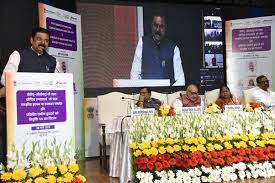
The Ministry of Rural Development has launched a new initiative called “Captive Employment” under the Deen Dayal Upadhyaya Grameen Kaushalya Yojana (DDU-GKY) program.
- Captive employers are any Employer or Industry that provides employment to candidates in their own organization or one of its subsidiaries and has suitable in-house training facilities.
- It aims to train and place more than 31,000 rural youth in their own establishment or subsidiary companies.
- The trained candidates are assured post-training placement of a minimum of six months with a minimum CTC of Rs 10,000/-. The program is expected
Deen Dayal Upadhyaya Grameen Kaushalya Yojana:
- Launched in 2014
- Ministry: Under Rural Development
- Part of the National Rural Livelihood Mission (NRLM)
- Objective is to Demand-led skill training aimed at rural poor youth between 15 and 35 years of age. Mandatory coverage of socially disadvantaged groups (SC/ST 50%; Minority 15%; Women 33%). The emphasis is on Career Progression rather than just training.
Institution Of Eminence Scheme:
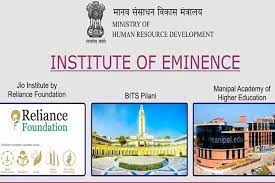
There are many Institutes which, after being selected for the Institution of Eminence (IoE) Status, are still waiting for the IOE status for more than three years.
- The central Government formulated the IoE scheme to establish 20 prestigious educational institutions in the country.
- It was introduced by the University Grants Commission (UGC) in 2017 that required the IoE scheme to receive accreditation within five years of notification.
- The status of ‘Institute of Eminence’ was launched to empower higher education institutions in India and help them implement world-class teaching systems to enhance affordable access to high-quality education.
- Twenty institutions (10 Public and 10 Private Institutions) received the grant, and eleven among the selected ones got the Institutions of Eminence status in April 2021.




